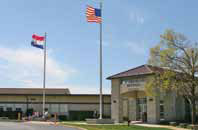Back-Office Business : How schools are solving problems with tech

Small New Hampshire district makes big wireless change
Challenge: Amherst School District in New Hampshire had to upgrade its ad hoc wireless network after complaints about frequent dead spots and after school board members expressed concern about security problems.
Solution: The district selected Enterasys Wireless because it provided more comprehensive and reliable network coverage than Amherst’s existing system and an intuitive management platform. I n addition, the technology ensures student confidentiality and data integrity. Amherst’s network administrator chose Enterasys because of its technology capabilities, customer service and support, and expertise in the K–12 education market.
Digital radio keeps large, hilly district in touch

Challenge: The Dallas County R-I School District is located in the heart of the Ozarks of Missouri. The area is beautiful and scenic, but its steep terrain, tree-covered hilltops, and large expanse make busing children to and from school a challenge. The bus drivers used analog two-way radios to communicate, a problematic method: It was hard to get through, audio quality was very poor, and drivers had to repeat themselves, creating more radio traffic. The district set out to find a more reliable communication solution.
Solution: Dallas County chose MOTOTRBO digital twoway radios with IP Site Connect. Now the bus drivers have access to nearly 100 percent coverage wherever they are within the district. They can understand each other, and radio traffic has cleared up.
Texas district connects students, teachers, lessons

Challenge: The Atlanta Independent School District in Texas wanted to become a model for the use of digital content, interactive media, and educational technology in support of student learning.
Solution: Lightspeed Systems’ My Big Campus lets students and teachers collaborate and communicate safely. It acts as an extension of the classroom, taking discussions, assignments, and curriculum to a safe online environment. The site is part of a Web filter and allows administrators to assign, monitor, and report on user permissions and policies.
Internet filter offers security, flexibility for California schools
Tools and ideas to transform education. Sign up below.

Challenge: An important element of the mission of California’s Lassen County Office of Education is to ensure the safety of students while accessing online material: shielding them from inappropriate sites while on campus but still providing complete use of the Internet. Additionally, LC OE wanted a standard Webfiltering system that would be flexible enough for the disparate policies set by the school districts.
Solution: LCOE discovered Phantom Technologies, a global provider of Internet filtering and security solutions, including the iBoss. The education office chose the iBoss with the clustering feature because the solution lets sites be managed through one appliance and consolidates reports from all sites into one centrally managed appliance. The iBoss also generates graphs to show activities based on time, allowing the LCOE’s technology staff to adjust network layouts, customize filtering, and identify risks before they become problems.
